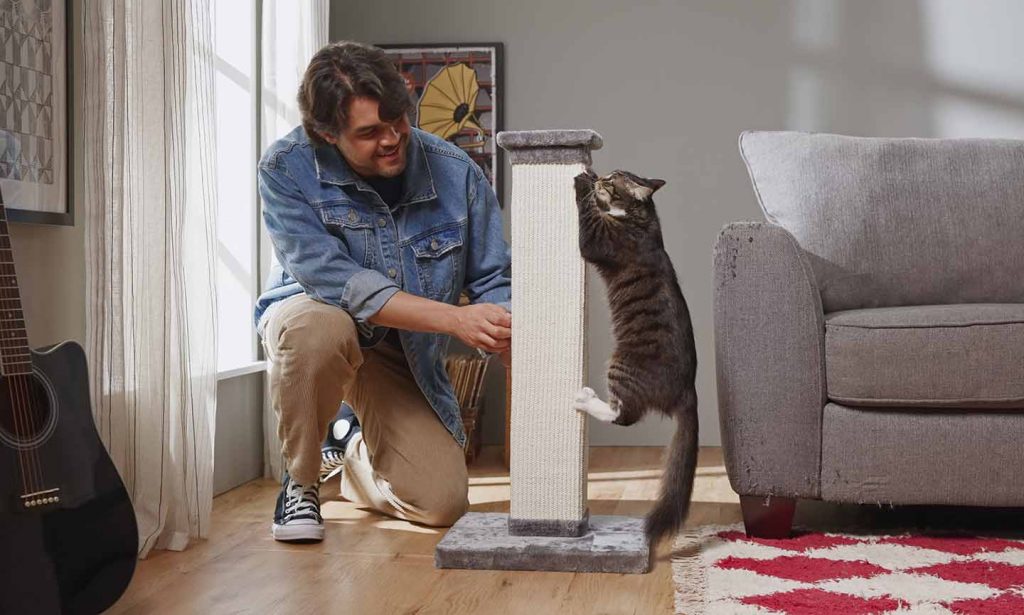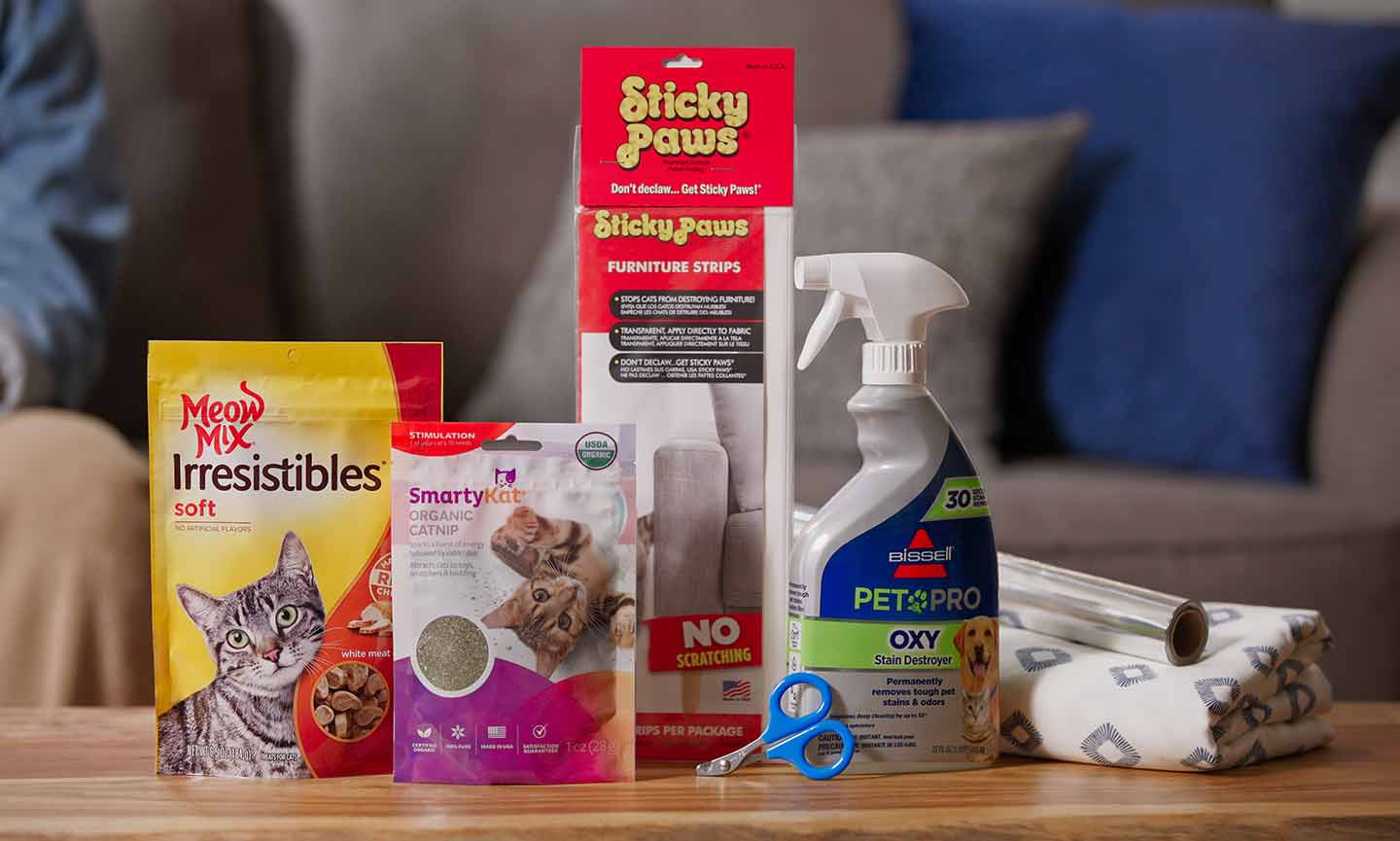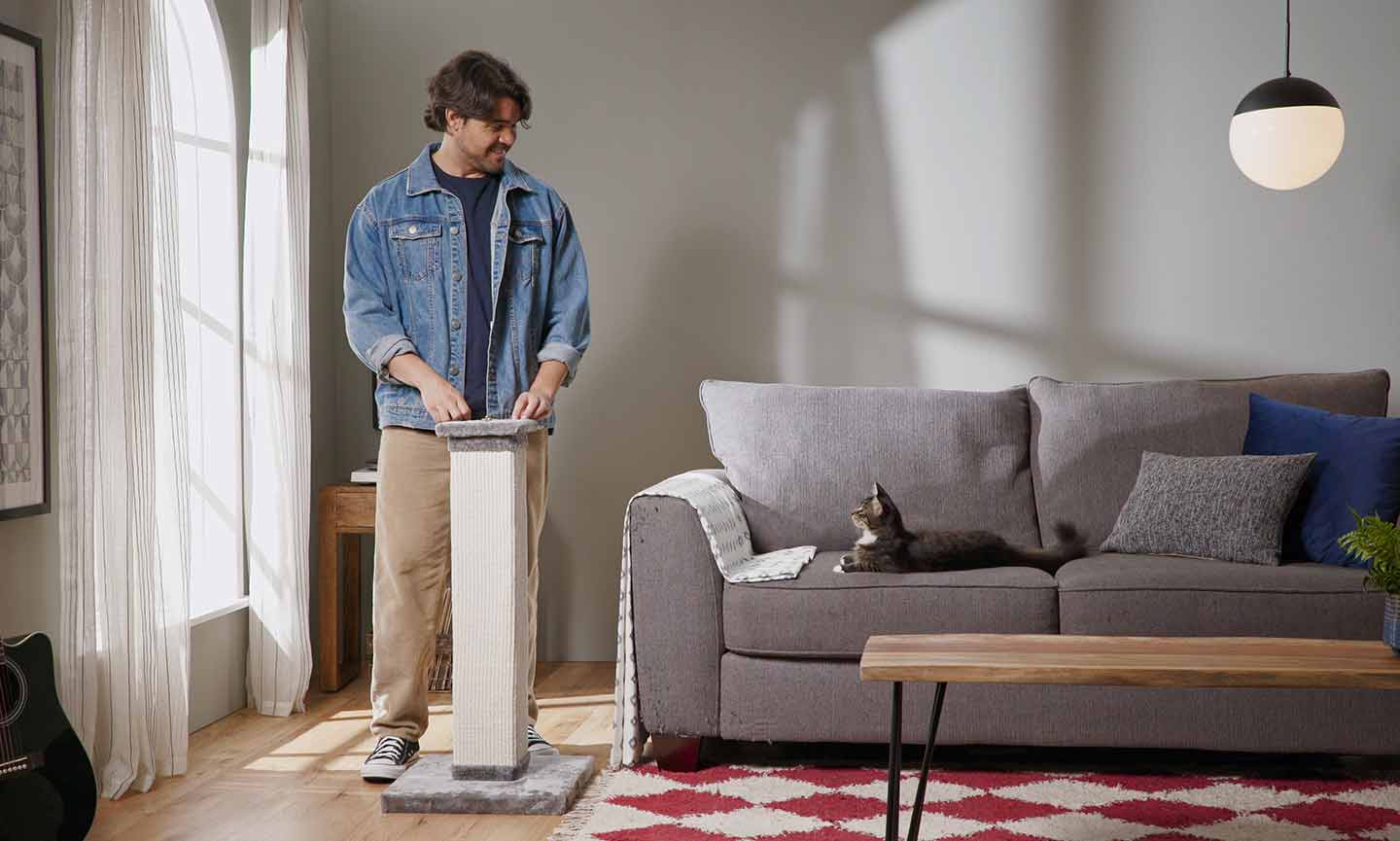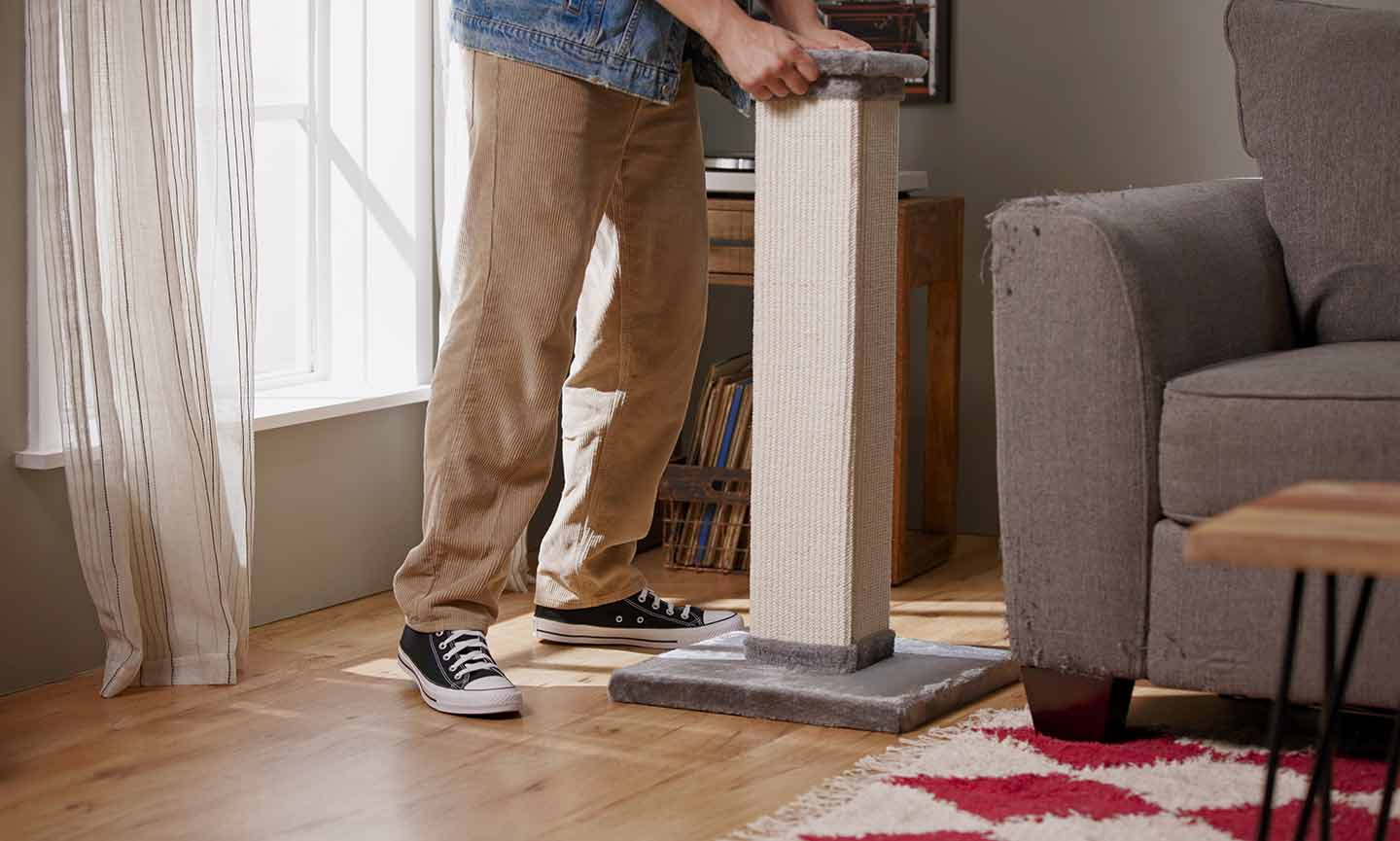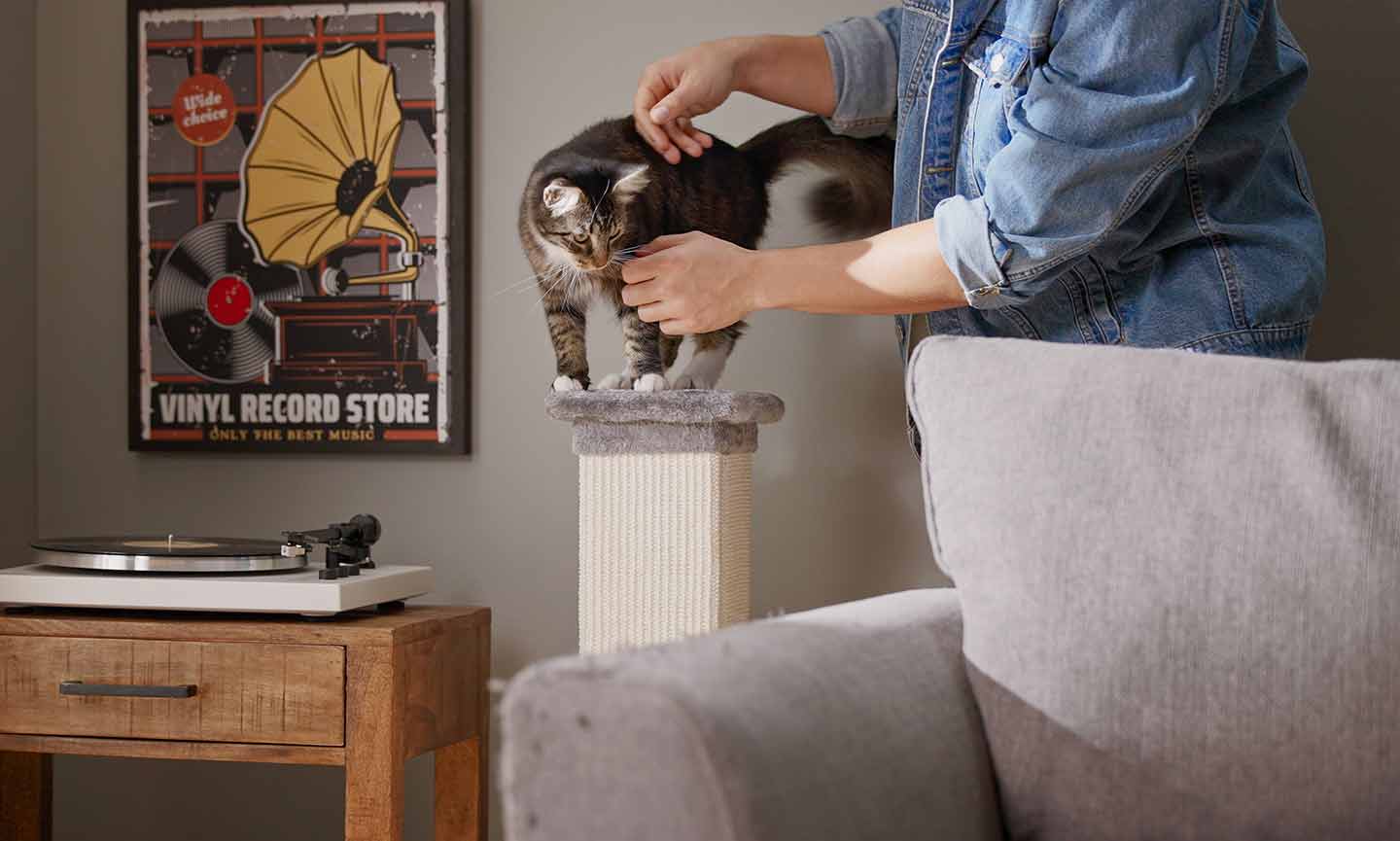Picture this: You’ve found the perfect sofa to complete your home’s aesthetic—but the moment it enters your home, your cat decides your new loveseat is their personal scratching post. You need to act fast to prevent further scratch marks. So, how do you keep cats from scratching furniture?
First, understand that your cat needs to scratch—cat scratching is an innate part of being a cat. That means it’s up to you to provide appropriate places for them to engage in this cat behavior (and to make those spaces more appealing than your tempting new furniture). Keep reading to learn how to keep cats from scratching furniture and why cats scratch in the first place.
Click the buttons to jump to each section:
Why Do Cats Scratch?
Big or small, purebred or mixed, feral or domesticated—all cats are instinctually inclined to scratch! There are a handful of key reasons why scratching is a natural behavior for cats:
- To sharpen their claws: “This is how they remove old nail and expose the new, strong, sharp portion of the nail,” says Dr. Gary Richter, DVM, owner of Holistic Veterinary Care in Oakland, California.
- To mark their territory: Because your cat’s paws have scent glands, scratching is a way for them to mark their territory. (Hey, at least it’s better than spraying! Save it for the litter box, kitty.)
- To express their emotions: Cats tend to scratch when they’re feeling excited or anxious, says Dr. Amanda Williams, DVM chief veterinarian at Furry Friends Adoption, Clinic & Ranch in Jupiter, Florida.
But why do cats scratch furniture, specifically? Dr. Richter says that cats are all about textures, and that they also often prefer using a vertical scratching surface. This makes the plush, upright sofas and chairs in cat households particularly tempting. The key is to let your cat scratch their little heart out, but to direct them to objects that are OK for their claws.
Supplies to Stop Cats From Scratching Furniture
If you’re at your wit’s end and want to learn how to keep cats from scratching furniture, you’re in the right place. There are a handful of highly effective methods for cat-proofing couches and other furniture, and many ways to redirect your cat’s destructive scratching behavior elsewhere, too.
Here are a few things you’ll need to help prevent cats from scratching furniture:
- Cat scratching deterrents: These can include pet-specific products like Sticky Paws furniture strips or other double-sided sticky tape products, and cat furniture repellants. You may also need general household items like sheets, blankets or aluminum foil. It may take some trial and error to determine which of these work best to deter your cat from off-limits furniture.
- Odor-neutralizing spray
- Cat scratchers
- Catnip
- Cat Treats
- Cat Toys
- Cat nail trimmer
How to Keep Your Cat from Scratching Furniture: Step By Step
1 Make Your Furniture Less Appealing
Do your best to make their favorite scratching ground undesirable. This means using cat scratching deterrents in the spots they frequent most.
One way to protect furniture from cat scratching is to cover it with a tight-fitting sheet or blanket. A nice throw blanket that covers their favorite spots can even be a nice decorative touch!
For small surfaces, cover the area with something that is sticky, smooth, or slick, like double-sided tape. Aluminum foil can also be an excellent deterrent, since many cats don’t like the noise it makes or the way it feels under their paws.
Another trick to stop cat scratching is furniture spray repellant. Cats dislike certain smells—like citrus or vinegar—and will steer clear of areas that have been sprayed.
Pro Tip: An odor neutralizing spray can also help fight your cat’s marking instinct. The theory is that it nixes the scent they left behind the last time they scratched. That makes them less likely to revisit the spot again.
2 Place Cat Scratchers Next to the Off-Limits Area
The next step in keeping cats from scratching furniture is to introduce a variety of cat scratchers or cat trees to your home. Every cat has their own preference, so offering a few options is best. For example, some cats prefer rope or carpet textures, while others like cardboard. Some like vertical surfaces while others like horizontal scratchers. Find out more about the different types of cat scratchers, then add a few to your home and observe to find out what’s the best cat scratcher for your unique kitty.
Encourage your cat to use the scratcher by putting it near their typical scratching area—for example, next to the couch. This way they’re still going to the same area of your home they typically frequent but are choosing—on their own terms—to scratch the more desirable scratcher. (You know how cats love to do things on their own terms.)
3 Slowly Move the Scratcher Away
Over time, you can slowly move the catch scratcher toward someplace in the house you would prefer. Just move it a little each day so the cat gets used to the change gradually.
Though you might be tempted to bring your cat over to the scratcher, Dr. Williams recommends letting your cats find and use it organically. However, there are some things you can do to expedite the process.
“Play with the cat with a laser light or a fishing rod toy in the vicinity of the scratching post so that the cat will begin interacting with the scratching post on their own terms,” she suggests.
She adds that you can also rub catnip on the scratcher to attract your cat to the area. (You won’t have to keep reapplying catnip forever—your cat will eventually become conditioned to go to the scratcher without the catnip.) Another option is to place their favorite toys or even a treat on top of the cat scratcher.
4 Redirect and Reward
Pro Tip: Keep the cat scratching deterrents in place as long as you can tolerate them. It may not be pretty or convenient, but it will help your cat become less interested in the furniture and a lot more interested in their scratchers. If you remove the deterrents and they go back to the off-limits spot, it’s a good idea to use the deterrents again.
5 Trim Your Cat’s Nails
For indoor-only cats, regular nail trims done every six weeks (or as needed) can help them to shed old nails and prevent nails from overgrowing and curling around to embed in the paw pads of your cat’s toes. It can also help reduce urgent desires to scratch your furniture.
You can clip your cat’s nails at home with nail clippers, like Frisco Dog & Cat Nail Clippers. Just make sure to only trim the very top portion of the nail to prevent cutting into the quick. If you’re nervous about clipping your cat’s nails, this is something you can have a veterinarian or groomer help with.
Need a primer on how to cut your cat’s nails? We’ve got you covered.
Outdoor cats likely won’t need their nails trimmed. Dr. Williams says, “For outdoor cats, their nails are part of their self-defense mechanism. Their claws should be checked regularly to prevent ingrown nails, but otherwise left alone.” Also, their nails tend to wear down naturally on the rougher surfaces found outside.
Pro Tip: Our experts do not recommend using nail caps, which can sometimes get caught on rugs and furniture as they start to grow out. This can lead to injury. Cats may also chew at them or ingest them as they fall off with time. Regular nail trims are preferred.
The Dangers of Declawing Your Cat
Even if you’re frustrated with your cat’s scratching habits, think twice before you consider declawing. Both the American Veterinary Medical Association (AVMA) and the American Society for the Prevention of Cruelty to Animals (ASPCA) are opposed to the procedure except as a last resort, as are many veterinarians, behaviorists and other animal lovers.
“The process of declawing is an amputation of part of the digit. Imagine having your fingers amputated at the first knuckle—that is what declawing is,” Dr. Richter explains.
Declawing can cause cats pain during and after the surgery, and many vets believe it can also cause behavior or personality shifts. Cats use their claws for play and defense, so declawing can make it more difficult for cats to do both of those things—and that can lead to behavior issues down the road. Dr. Richter says it can cause cats to develop a biting habit, since biting is their next best way to defend and play.
In general, positive reinforcement (aka rewarding good behavior, like in the steps above) is the best way to approach any type of training with your pet—including teaching your cat where to scratch appropriately.
Share:
